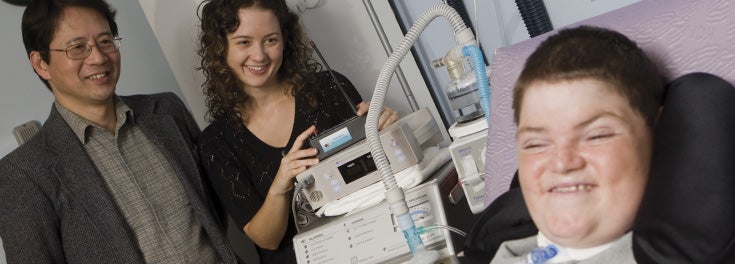
Many people face physical limitations that sometimes call for specialized help. But the customized equipment they need to improve their quality of life is often too costly for American firms to mass- produce.
Thanks to URI Biomedical Engineering Professor Ying Sun M.S. ’82 and his undergraduate and graduate students in URI’s assistive technology lab, more people are getting the tools they need for greater mobility. Such tools as automatic book-page turners, voice-activated nurse call systems, and the now-patented EZ-puff, a device that enables quadriplegics to control myriad appliances with a puff of air.
For professors and students here, using innovative techniques to build better prosthetic devices, develop assistive technology, and design neurological sensors that stop seizures is all in a day’s work.
Kyle Page’s parents were afraid to leave his side, for fear his ventilator would stop breathing for him. So Jenna Marcus ’09 helped design and build a remote ventilator alarm that alerts them if Kyle’s ventilator stops. Now, they have more freedom to take care of daily chores without worry.
Several years ago, Professor Sun’s students developed a finger-controlled device that allowed Tom Santagata to operate the audio-visual equipment in his home when his muscular dystrophy limited virtually all movement. Now that he’s nearly too weak for even that, they’re designing a voice-controlled system based on an Android Smartphone.
“We run the course like a business,” said Professor Sun. “First, students come up with ideas, then create a prototype, and then they make a business plan to launch it.” Typically, their ideas are generated through conversations with rehabilitation scientists, therapists, and even patients.” The students spend a lot of time listening to the users, looking at their issues and observing them in their environment, to ensure their devices are as personalized as possible and can make a meaningful difference in their lives.
Last year, Chelsae Meier ’12, led a team of students who would help Rebecca Beaton operate her greeting card design company more efficiently. The effects of cerebral palsy had made it possible for her to control only the movements of her head and neck, so Meier’s team, under Professor Sun’s guidance, designed a lightweight helmet with an attached flexible copper rod that could be used as a pointer, or adapted to grip pencils, paintbrushes and other tools. With it, Rebecca is now able to operate a computer, paint, draw, and use an iPad and Smartphone… and run her business.
The U.S. market for medical devices exceeds $300 billion per year. Behind that market is an army of biomedical engineers. Among them are professors and students at URI, where research in the field is transforming the way we think about treating medical conditions. For professors and students here, using innovative techniques to build better prosthetics, develop assistive technology, and design neurological sensors that stop seizures is all in a day’s work. And it’s not going unnoticed. URI’s biomedical engineering faculty attract funding from the National Institutes of Health, the National Science Foundation, Department of Defense, and the local and national medical device industries.
